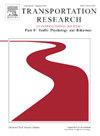How do winter conditions affect passengers’ intentions to use shared autonomous vehicles?
IF 3.5
2区 工程技术
Q1 PSYCHOLOGY, APPLIED
Transportation Research Part F-Traffic Psychology and Behaviour
Pub Date : 2025-05-19
DOI:10.1016/j.trf.2025.05.004
引用次数: 0
Abstract
Weather conditions can significantly impact the demand for shared autonomous vehicles (SAVs). The aim of this study was to assess how difficult winter conditions affect passengerś intentions to use SAVs. This study compares passengers’ real-life perceptions and feelings between winter and summer conditions, and provides the first insights to the effects of difficult winter conditions. A quantitative convenience sample (n = 195) was collected from passengers traveling on SAVs in three trials in Finland in 2020–2023. We applied the Theory of Planned Behavior and analyzed the data using a nonparametric Kruskal-Wallis H test and post-hoc pairwise comparisons tests. According to the results, passengers’ perceptions in winter and summer conditions showed no statistically significant differences. Passengers’ attitudes, subjective norms, and perceived behavioral control, and through that, their intentions to use SAVs were at a high level in both summer and winter conditions. Still, there were many differences between different user groups, especially in winter. In difficult winter conditions, passengers’ readiness to use SAVs and their willingness to shift from non-motorized modes of transport to SAVs can affect positively the use of SAVs. As the most important key finding, the study highlights the significance of speed. If the speed cannot be increased, the use of SAVs will not be beneficial for large masses of users. The article concludes that more research is needed both on winter condition-related factors and also on changes in passenger attitudes as the speeds of SAVs increase and remote operators replace safety drivers.
冬季条件如何影响乘客使用共享自动驾驶汽车的意愿?
天气状况会对共享自动驾驶汽车(sav)的需求产生重大影响。本研究的目的是评估困难的冬季条件如何影响乘客使用自动驾驶汽车的意图。这项研究比较了乘客在冬季和夏季条件下的真实感知和感受,并首次提供了对艰难冬季条件影响的见解。在2020-2023年芬兰的三次试验中,从乘坐sav的乘客中收集了定量便利样本(n = 195)。我们应用计划行为理论,并使用非参数Kruskal-Wallis H检验和事后两两比较检验分析数据。结果显示,乘客在冬季和夏季条件下的感知没有统计学上的显著差异。乘客的态度、主观规范和感知行为控制,以及通过这些,他们在夏季和冬季条件下使用sav的意愿都处于较高水平。尽管如此,不同的用户群体之间还是有很多差异,尤其是在冬天。在困难的冬季条件下,乘客使用自动驾驶汽车的意愿以及他们从非机动运输方式转向自动驾驶汽车的意愿可以对自动驾驶汽车的使用产生积极影响。作为最重要的关键发现,该研究强调了速度的重要性。如果不能提高速度,那么sav的使用将不会对大量用户有益。文章的结论是,需要对冬季条件相关因素以及随着sav速度的提高和远程操作员取代安全驾驶员乘客态度的变化进行更多的研究。
本文章由计算机程序翻译,如有差异,请以英文原文为准。
求助全文
约1分钟内获得全文
求助全文
来源期刊
CiteScore
7.60
自引率
14.60%
发文量
239
审稿时长
71 days
期刊介绍:
Transportation Research Part F: Traffic Psychology and Behaviour focuses on the behavioural and psychological aspects of traffic and transport. The aim of the journal is to enhance theory development, improve the quality of empirical studies and to stimulate the application of research findings in practice. TRF provides a focus and a means of communication for the considerable amount of research activities that are now being carried out in this field. The journal provides a forum for transportation researchers, psychologists, ergonomists, engineers and policy-makers with an interest in traffic and transport psychology.

 求助内容:
求助内容: 应助结果提醒方式:
应助结果提醒方式:


